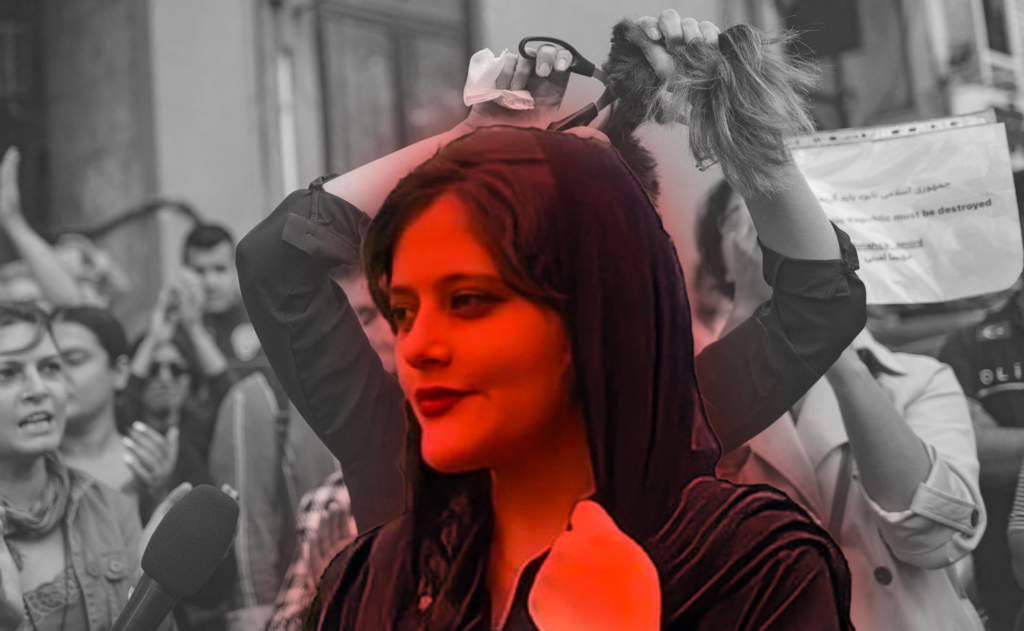In an incident that sparked widespread condemnation, Mahsa Amini, 22, passed away under the custody of the Iranian morality police, who arrested her for wearing her hijab “inappropriately” on Sept. 16. On a visit to her family three days before her death, she was confronted and arrested on the basis of needing training on Iran’s mandatory hijab rules by Iran’s morality police, who enforce the conservative Islamic behavior and dress laws.
Amini was taken to a detention center where she, according to officials, experienced a heart attack and died. A coroner’s report officially attributed Amini’s death to multiple organ failures caused by cerebral hypoxia, a condition in which there is a decreased oxygen supply to the brain despite normal blood flow. The report did not confirm the cause of these injuries, however.
On the other hand, various witness accounts paint a different picture. Some claimed that Amini was beaten by the police on the way to the detention center in the patrol car. Her father purportedly caught a glimpse of her bruised foot at the hospital. After her death, videos surfaced of Amini’s face covered in bruises with blood dripping from her ear. A former commander of Iran’s Revolutionary Guards Corps also released an audio file reporting that the cause of her death was a skull fracture resulting from multiple heavy blows to her head.
Amini’s death has outraged thousands of Iranians, who started leading protests across dozens of cities in September. Many women burned hijabs and cut their hair to stand in solidarity with Amini.
Among those also concerned with the incident and others like it in Iran are students, parents and local community activists.
For sophomore Sameera Kapur, who is half-Iranian and half-Indian, the murder of women and citizens for failing to follow Iran’s policies “isn’t new at all,” but rather a continuation of the regime’s oppressive laws.
“Laws that suppressed women’s rights in the past have built the foundation of the social unrest you see being fought for now — [the death of Amini] just acted as a breaking point,” Kapur said.
Long-standing tensions over hijab-wearing in Iran
In 1936, during the Pahlavi dynasty, former Shah Reza Pahlavi instilled a law forbidding hijabs to be publicly worn as an effort to westernize Iran. While the law was extremely unpopular and ended a few years later with new conservative dress laws, it introduced the hijab as a critical aspect in the battle over national identity, religious authority and political power.
In the Iranian Revolution in 1979, the Pahlavi dynasty was replaced by the Islamic Republic of Iran, the nation’s current ruling government. Under the republic, Iran’s already-conservative dress and hijab laws became more strictly enforced and started requiring Iranian women to completely cover their hair in public with a hijab to prevent them from trying to “attract male attention.” Because women were required to wear them in public, the hijab became a symbol of the Islamic Republic’s power.
“If it was about modesty, then yes, women who cover themselves would do it for modesty,” Kapur said. “But [what’s going on right now] is beyond just that modesty aspect; it becomes the government basically weaponizing religion in order to suppress women.”
According to an opinion article written by the Editorial Board of the New York Times, these actions reflect the government’s belief that keeping women in their place is critical to its survival in power. The same article claims that Iran believes that global isolation may be damaging the regime, but that global integration could introduce an even more threatening factor to their objective of repressive rule by introducing liberal ideas.
To limit what it sees as dangerous, western ideals, the regime aims to maintain a stable balance of transparency and confidentiality through what Karim Sadjadpour, a senior fellow of the Carnegie Endowment for International Peace, calls “just the right amount of isolation.” These efforts have led to the perpetuation of human rights mistreatment. In March 2021, a study conducted by the Human Rights Council found that women and girls in Iran continue to be treated as second-class citizens.
Kapur cited the experiences of her mother, who lived in Iran as a teenager before she immigrated to Canada in the early 1990s and the U.S. around the early 2000s. She recalls her shock at hearing the daily abuse her mom witnessed of women who did not conform to the conservative laws after the leaders of Islamic Republic of Iran took control — an occurrence she says is not out of the ordinary in the country.
“Imagine being 7 years old, walking down the street and seeing someone getting beaten to death because they showed their ankle or hairline,” Kapur said.
While Kapur’s mom lived through a strict government that often seemed to monitor women’s every movement, Iran activist Yeganeh Mafaher said that more Iranians now take the repressive laws less seriously than they did in previous decades, citing photos of women wearing their hijab looser. However, the Iranian government is still making its hijab mandates as strict as ever. This conflict between government policies and the push for less restrictive rules has now led to increasing waves of protests.
Protests across Iran rise
The protests following Amini’s death soon became an expression of the gap between their demands for women’s rights to their bodies and the current conservative laws of the government.
Other protestors staged smaller, numerous and quicker gatherings by blocking the streets with cars and dumpster bins to slow down security forces and prevent the police from reaching larger protests.
All protests demanded an end to the mandatory hijab rule and advocated for wider freedoms and women’s rights. Iranians from all different backgrounds have gathered to demand fundamental rights and protest the harsh realities of living under an authoritarian regime, where highly concentrated and centralized power is perpetuated by political and religious repression.
The police used batons, tear gas and guns with metal pellets to suppress these peaceful protests. According to Iran Human Rights, as of Dec. 2, at least 469 people have been killed by security forces. Additionally, the Iranian government implemented regional shutdowns of internet access and nationwide restrictions on social media that eventually evolved into a widespread internet blackout, making it harder for people to organize protests, document abuse and share information.
These protests are a continuation of ones that have been on-and-off since the Iranian Revolution in 1979. In the month following this revolution, rumors of the new hijab-mandate spread and dozens of women were arrested trying to defend their rights. As of Dec. 2, however, as many as 18,210 protesters have been detained since the protests began, a severely exponential increase from the past.
With this exponential increase in arrests and deaths, Iranians are worried that a bigger movement might endanger even more. Even now, 95% of Iranians are worried about the livelihood of themselves and their children both today and in the future, according to a study conducted by conservative analyst Abdolreza Davari.
These movements, however, were recently able to come to fruition. Following nationwide protests after Amini’s death, Iran’s morality police were successfully suspended — at least in the short term.
“These kinds of protests about the government progressively get worse; it just builds up over time until something happens,” Kapur said.
The worldwide response to Iran’s protests
People across the world have demonstrated support for the women in Iran.
The U.S. has aided protests by condemning the death of Amini through social media and lifting internet sanctions to help Iranians evade online censorship. The Biden administration is also trying to establish alliances with other countries to defend themselves in the case of war and attempting to avoid escalation of the protests.
As an American citizen who had lived in Iran for one year in 1977 before moving to the U.S., however, San Jose resident Ruth Conte-Morris believes that the U.S. will likely not get involved in Iran’s political issues.
“The people voted [the current regime in] so the U.S. cannot just go into a country and say, ‘hey you’re treating your people badly, so we’re going to come and liberate them,’” Conte-Morris said.
This, however, doesn’t mean that the public is sitting back and waiting for Iranian citizens to deal with this problem on their own. While the public cannot deal with the entire Iranian government, individuals have instead focused on helping the people living in Iran.
For example, many have shown support for Iranian women through social media. Female influencers on TikTok have expressed their support symbolically by cutting off chunks of their hair.
Coldplay, the popular rock band, also performed a cover of the Iranian protest anthem on Oct. 30, a song that had been used repeatedly during protests, to express their solidarity.
The band included Golshifteh Farahani, an exiled Iranian actor, who sang in Farsi with them during their world tour in Buenos Aires, Argentina. Their concert was streamed via satellite in 81 countries. “Baraye,” a song written by Iranian singer Shervin Hajipour, included messages that citizens had posted online sharing their pain and grief during the protests.
In Farsi, Baraye means “For” or “Because of” and some of its lyrics, such as “for dancing in the streets,” “for every time we were afraid to kiss our lovers” and “for women, life and freedom,” have become chants used during protests.
The Global Citizen, an online news platform that intends to help people all around the world, recommends increasing awareness and donating to the Iranian American Women Foundation or the Women’s Committee of the National Council of Resistance in Iran, which are currently raising funds to support the women in Iran.
“I feel so very proud of the Iranian women who have risked their lives to fight for change and awaken the world to the true situation there. They own this new revolution,” Conte-Morris said. “Without them, nothing would have happened, and the world would not know about these disgruntled people living in a totalitarian country that devalues their people.”
Residents like Poopak Tameh and Shahla Pakbaten, who both immigrated from Iran, recommend helping Iranian people by signing petitions about closing embassies in Iran and spreading awareness on social media.






























